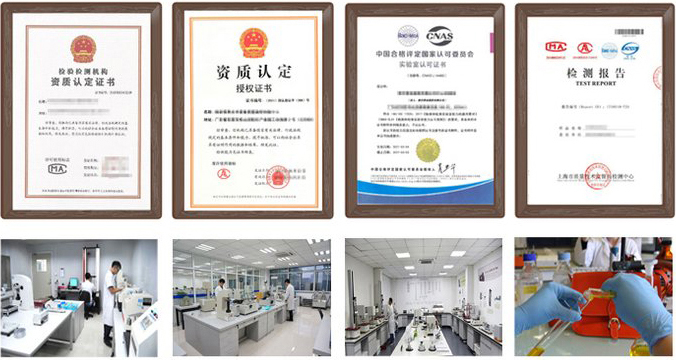Powder testingHow to apply for a report? What items need to be tested? We will conduct testing and evaluation in strict accordance with the standards. We can also provide personalized testing plans and reports according to your needs.
The methods for detecting the ingredients of prickly heat powder mainly include the following:
1. Sensory detection method
The sensory detection method is a method for preliminary evaluation of prickly heat powder through human senses (such as vision, smell, etc.).
Appearance inspection: observe the color of the prickly heat powder, the fineness of the powder, and whether there are impurities or agglomeration. High-quality prickly heat powder should have a uniform color, fine powder, and no impurities.
Odor detection: Evaluate the smell of the prickly heat powder by smell to determine whether it has a peculiar or irritating smell. Prickly heat powder usually contains additives such as flavors and should have a pleasant aroma.
2. Chemical analysis method
The chemical analysis method is to determine the content of specific ingredients in prickly heat powder through chemical reactions or instrumental analysis.
Qualitative analysis: Use chemical reagents or instrumental analysis methods to determine whether the prickly heat powder contains specific chemical ingredients, such as talcum powder, zinc oxide, salicylic acid, etc. This helps to confirm whether the main ingredients of the prickly heat powder meet the requirements of the product label and relevant standards.
Quantitative analysis: The content of specific ingredients in prickly heat powder is determined by precise instrumental analysis methods. For example, the content of ingredients such as talcum powder and zinc oxide can be determined using a UV-visible spectrophotometer. This helps ensure that the content of active ingredients in prickly heat powder meets the specified range, thereby ensuring the quality and effect of the product.
3. Instrumental analysis method
The instrumental analysis method is a method of accurately analyzing the ingredients of prickly heat powder using advanced instruments and equipment.
Atomic absorption spectroscopy (AAS): used to determine the content of heavy metals (such as lead, mercury, arsenic, etc.) in prickly heat powder. These heavy metals are harmful to human health, so their content must be strictly controlled.
Inductively coupled plasma mass spectrometry (ICP-MS): also used to determine the content of heavy metals in prickly heat powder, with higher sensitivity and accuracy.
Infrared spectrometer: used to analyze organic components in prickly heat powder, such as talcum powder, corn starch, etc. The infrared spectrometer can provide functional group information of compounds, which helps to determine the composition and structure of prickly heat powder.
Particle size analyzer: used to determine the particle size distribution of prickly heat powder, that is, the proportion of particles of different sizes in the powder. Particle size distribution has a certain impact on the use effect of prickly heat powder, so it needs to be tested.
4. Microbial detection method
The microbial detection method is used to evaluate the microbiological safety of prickly heat powder.
Total colony count detection: Determine the total number of bacteria in prickly heat powder to evaluate its hygiene status.
Total mold and yeast count detection: Determine the total number of mold and yeast in prickly heat powder to evaluate whether it is contaminated by mold and yeast.
Specific pathogen detection: Such as fecal coliform group, Pseudomonas aeruginosa, Staphylococcus aureus, etc. These pathogens are harmful to human health and their content must be strictly controlled.
5. Other detection items
In addition to the above main detection methods, the detection of prickly heat powder ingredients may also involve the following items:
pH value determination: Measure the pH value of prickly heat powder to evaluate whether its pH is suitable for skin use.
Moisture and volatile matter detection: Determine the moisture and volatile matter content in the prickly heat powder to ensure the stability and use effect of the product.
Additive analysis: Check the additives used in the prickly heat powder, such as flavors, preservatives, antioxidants, etc., to ensure its safety and compliance.
Asbestos detection: According to relevant standards, detect whether the prickly heat powder contains asbestos because asbestos is harmful to human health.
In summary, the methods for detecting the ingredients of prickly heat powder include sensory detection, chemical analysis, instrumental analysis, microbial detection, and other detection items. By comprehensively applying these methods, the composition and quality of prickly heat powder can be comprehensively evaluated to provide consumers with safe and effective products.
Test report function
1、Project bidding: issue authoritative third-party CMA/CNAS qualification report;
2、E-commerce platform entry: quality inspection reports recognized by major e-commerce platforms;
3、Used as sales report: issuing a test report with legal effect to make consumers feel more at ease;
4、Papers and scientific research: providing professional and personalized testing needs;
5、Judicial services: providing scientific, fair and accurate testing data;
6、Industrial problem diagnosis: verifying the troubleshooting and correction of problems in industrial production;


 National free customer service telephone 400-101-7153
National free customer service telephone 400-101-7153 

